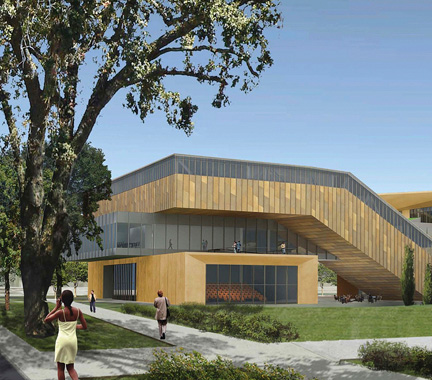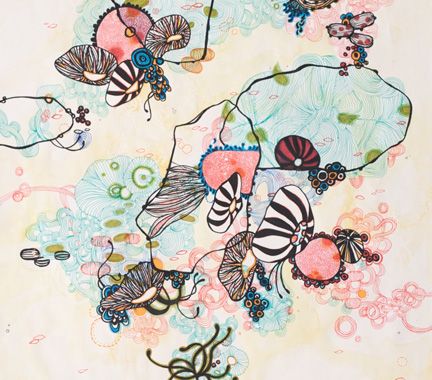
As part of the commitment to make the arts integral to a Stanford education, a new arts district has taken shape around Palm Drive.
Anchored by the Cantor Arts Center, Memorial Auditorium, Stanford Art Gallery, and Frost Amphitheater, new facilities include Bing Concert Hall, the Anderson Collection at Stanford University, and the McMurtry Building for the Department of Art & Art History.
Arts District

Anderson Collection at Stanford University
Stanford University is the home to the core of the Anderson Collection, which was one of the most outstanding private collections of post-World War II American art in the world. It was donated to the university by Harry W. and Mary Margaret Anderson, and Mary Patricia Anderson Pence, the Bay Area family who built the collection over nearly fifty years, in 2014. Stanford constructed a permanent building dedicated exclusively for the Anderson Collection that opened in September 2014.

Bing Concert Hall
The 842-seat Bing Concert Hall is a state-of-the-art venue suited to a wide range of music performances, from small chamber ensembles to full-sized orchestra, jazz, and multimedia events. The acoustical design is by Nagata Acoustics’ Yasuhisa Toyota (whose resume includes the Walt Disney Concert Hall in Los Angeles). Named in honor of major supporters Helen and Peter Bing, ‘55, the concert hall is located at the gateway to the Stanford campus, adjacent to the existing Frost Amphitheater, at the east end of Museum Way, with its main entry plaza facing the Cantor Arts Center on the other side of Palm Drive. The first public performances took place in January 2013.

Cantor Arts Center
The Cantor Arts Center boasts a proud and venerable history, as it was conceived of in tandem with the founding of Stanford University itself. The Stanford family, including Leland Jr., traveled the world collecting objects of art and cultural interest. The museum was originally created to make this collection available to students and the public. It has withstood natural disasters and periodic neglect, only to be resurrected, renewed, and expanded, with its collections stronger than ever, thanks to the passionate dedication of Stanford faculty and staff, and art lovers in the surrounding community.

McMurtry Building
The new McMurtry Building, a home for the Department of Art & Art History, is located adjacent to the Cantor Arts Center and houses the department’s programs in art practice, design, art history, film and media studies, and documentary film. The 96,000-square-foot building, designed by prominent architectural firm Diller Scofidio + Renfro in collaboration with Boora Architects, serves as an interdisciplinary hub for the arts at Stanford, furthering the ongoing development of the arts district at the entrance to campus. The building welcomed students in the fall of 2015 and was officially dedicated on Oct. 6, 2015.
Other Arts Facilities
Memorial Auditorium
Memorial Auditorium, or MemAud, as the building is affectionately known on campus, is Stanford’s largest indoor facility designed for regular performance use. It seats up to 1,750 people, and is also the home of the cozy Pigott Theater, which holds nearly 200 people. In addition to faculty and staff offices for the Department of Theater and Performance Studies (TAPS), the building houses the storied light lab and costume, prop, and scene shops. The auditorium’s rich history began in 1937 with Twelfth Night.
Roble Gym | Opening Summer 2016
Roble Gym, a historic structure which opened as the women’s gym in 1931, is being renovated with a new flexible-configuration black-box style theater and improved dance and rehearsal studios for the Department of Theater and Performance Studies (TAPS). The renovation will also include the Arts Gym, a one-of-a-kind drop-in art-making studio and performing arts space. Boasting a flexible space for everything from informal performances to theatrical rehearsals to video production, the gym will be a hub for your arts practice with the swipe of your student I.D.

Gallery160, Lakeside Gallery & The Wall at Cool Café
As part of the new Your Art Here program, launched in fall quarter 2010, the Stanford Arts Institute, Wallenberg Hall, Lakeside Dining, and the Cantor Arts Center have launched three new spaces for displaying rotating exhibits of student artwork. Gallery160 is located in the Wallenberg Hall lobby and supports the display of large exhibitions; The Wall Student Gallery at Cool Café in the Cantor Arts Center allows for prominent display of solo artist or small group show exhibits; and Lakeside Gallery at Lagunita Dining Hall can support 3D works and displays of large exhibitions.
Manzanita Dining Hall
In Fall 2010 the Stanford Arts Institute cosponsored installation of lighting and sound equipment in Manzanita Dining Hall, enabling the space to be better used for performances.
Kimball Hall Multimedia Studio
In May 2010 Kimball Hall became Stanford’s official Arts Theme House. The Stanford Arts Institute cosponsored the setup of a multimedia and recording studio space in the residence, which has been used to create podcasts, animations, productions, and musical recordings by Kimball arts-focus residents. With technology upgrades to the lounge space, Kimball also supports small-scale intimate concerts, workshops, and performances.

White Plaza Stage
During the 2008 renovation of White Plaza, a large outdoor stage was created adjacent to Dinkelspiel Auditorium. The stage has been used for outdoor concerts, performances, and the annual student-run Arts + Sustainability Festival in the spring.

Hasso Plattner Institute of Design (d.School)
In May 2010, the Hasso Plattner Institute of Design, more commonly known as the d.School, opened the doors to its new home in Building 550. The building serves as a permanent home for the d.School students and faculty.
Stanford Coffee House
In 2009 the Stanford Arts Institute and the Stanford Concert Network cosponsored installation of a permanent sound system to support the more than 150 performances that take place there annually. An art tracking system was also installed in the space, which launched the first student-run gallery space on campus as part of the Your Art Here program sponsored by the Stanford Arts Institute. In 2010 the Stanford Arts Institute also assisted in the purchase of a new piano for the Coffee House, enabling it to better support the ongoing jazz concerts, jam sessions, and musical performances.

Stanford Ceramics Studio
Stanford’s new Ceramics Studio opened its doors in October 2008 to an enthusiastic student body. Created with the financial support of the Steven Denning and Roberta Bowman Denning Fund, the studio is a completely student-run facility and offers quarterly memberships, classes, and workshops for Stanford students.
Stanford Ceramics Club Website
Nitery Theater
The Nitery black-box theater was recently upgraded as part of the renovation of Old Union, completed in 2007. The space has flexible seating capacity of up to 85 and can adapt to a wide range of seating and staging formats. This fully-equipped space is primarily used for directing workshops and student theater productions.
Arrillaga Family Dining Commons
The new Arrillaga Family Dining Commons, the first dining hall to be built on campus in almost twenty years, opened fall quarter 2011. This 26,000-square-foot dining facility features a dance-friendly sprung floor and a new student performance space.